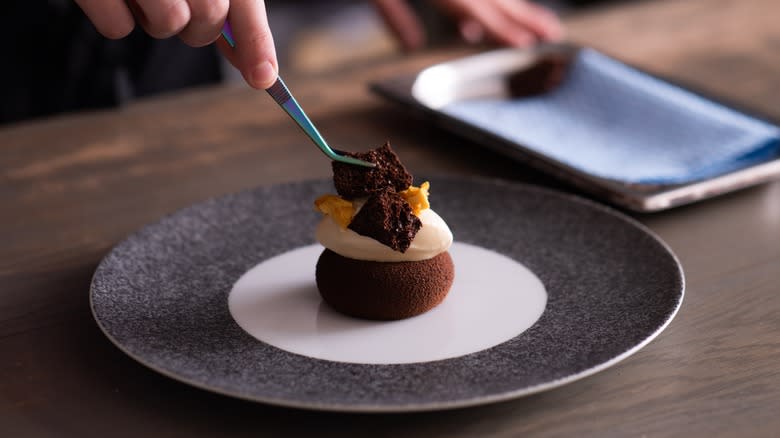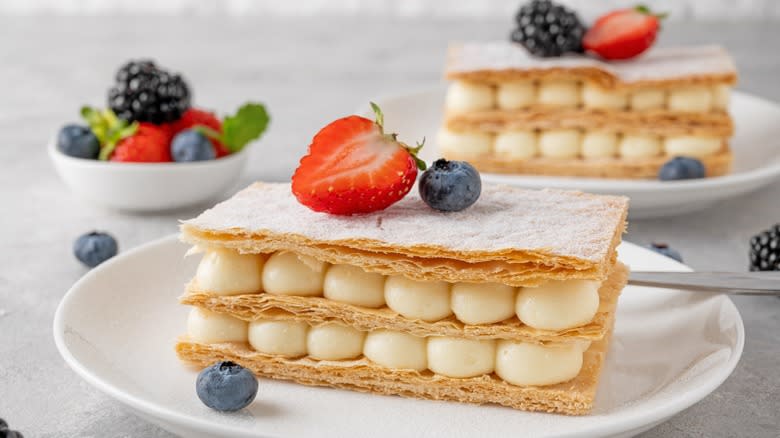The History Behind Why We Eat Dessert After Dinner

When you're relishing a nice dinner, there's an expected rhythm to the experience. Start with a nice drink, followed by a round of light, yet mouth-watering appetizers. Continue with a delectable entree, likely joined by some hearty sides. And then, finish with the dessert -- for some, the awaited highlight. Such a progression seems so natural, it may even feel silly to question it. Yet, it hasn't always been the designated order of dining, instead simply an engrained widespread expectation. It's a strong factor that influences your food perception, making your brain assume that the last bite will be sweet.
The history behind this ordering is storied and shaped by many external factors. As with many Western culinary practices, what we call dessert is most strongly linked with France, where haute cuisine prepared for aristocrats enacted new dining trends. However, there is also a biological component having to do with digestion. Consuming fatty and sugar-rich foods can be strenuous on an empty stomach, making it favorable to eat something first. Plus, we're predisposed to sugary bites being ever-so-tempting, so it's also easier to indulge on dessert once we're full. Such factors influence our dining patterns, but don't outright define our culinary history.
Read more: 30 Types Of Cake, Explained
The Concept Of A Standalone Sweet Meal Has Existed For Centuries

Per dictionary definition, a dessert is served to conclude a meal, not just a standalone sweet treat. The name comes by way of France, first found in print in 1539. It's a conjugation of the word "desservir", and references the act of clearing the table. Some of the very first foods bearing the name were small snacks like candied nuts and fruit. During this era of French dining, it was more common to serve dishes that blurred the lines of sweet and savory. And elsewhere, the culinary tradition of sweet dishes had already been around for hundreds of years.
In the dessert-heavy cuisines of Anatolia (now Turkey), people had been consuming a sweet pudding called ashure -- also known as Noah's Pudding -- since the early days of Christianity, lending it the moniker of world's oldest dessert. From this region, you should also know the ancient pistachio pastry katmer, as well as variations of baklava and lokum, which have origins dating to around the 15th centuries. While not strictly intertwined with a post-dinner meal, these dishes did have been enjoyed as a conclusion to Ramadan meals for centuries, lending them a dessert-like status that developed in parallel to European traditions. Meanwhile in Europe, serving opulent and unexpected displays of fruit was fashionable, setting the stage for a designated dessert course.
Our Modern-Day Dessert Emerged In 17th Century France

Sugar and status have long been intertwined, which made the first desserts a cultural concept reserved for aristocrats and royalty. Until widespread imports during the 17th century decreased prices, sugar was a prized and expensive commodity in Europe. As a result, from around the 15th to 17th centuries, sweetened meals were seen as lavish, so cooks would add sugar into stews, seafood, and meat dishes. Perhaps a small standalone sweet bite -- called an entremet -- would be enjoyed in the midst of savory bites, but there wasn't a designated sweet course.
Such a standalone dish, which is basically our modern idea of a dessert, came about in the 17th-century. Its first appearance in print is attributed to food writer François Pierre La Varenne, who advocated for the separation of sweet and savory. Chefs started crafting elaborate sculptures from sugar to visually flaunt sweet foods. Soon after, the origins of service à la russe, or serving dishes one by one, took place. It all coalesced into the practice of eating a sweet plate after the main affair, with all savory dishes put away. Some of the first standalone desserts like the alluring history of the millefeuille kicked off, ingraining the concept of a sweet course into history. And Western dining has stuck to the ordering ever since, clearing off tables to showcase a delectably sweet finale.
Read the original article on Tasting Table.


